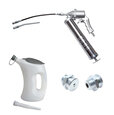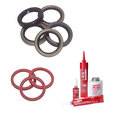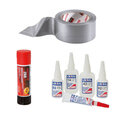What are sealants and adhesives?
Sealants and adhesives are mechanical parts or chemical solutions that are used to prevent leakage of fluids and unscrewing of threaded pipe connections, to seal flange faces, to lock different types of joints, and to re-connect broken pieces of an object. The sealants work by filling the space between the male and female threaded connections. They can also provide additional strength and durability to the bonded surfaces. Due to the diversity of applications, there are many different types of sealants and adhesives and many selection criteria that would provide you with the right choice.
View our online selection of lubricants, sealants and adhesives!
Table of Contents
- PVC adhesive
- Face sealants
- Gaskets and tape
- Instant adhesives
- Joint lockers
- Surface modifiers
- Threadlockers
- Thread sealants
- Product selection guide
PVC adhesive
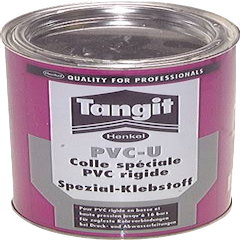
Figure 1: PVC adhesive
PVC adhesives are used to permanently connect a PVC pipe to a PVC fitting. Using a PVC adhesive ensures that this connection is solid, sustainable, and won’t become loose over a period of time. It is important to clean the pipe and fitting beforehand so it is free of moisture and grease before applying the PVC fitting adhesive.
Face sealants
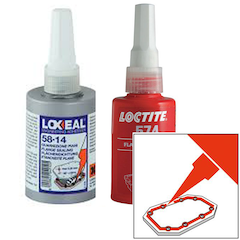
Figure 2: Face sealants
Face sealants replace traditional pre-cut gaskets and guarantee a tight seal between two surfaces. Due to the strong chemical nature of these products they are highly resistant against temperature, pressure, oxidation, and vibrations. Liquid face sealants can be anaerobic liquids or fast-curing plastics. These sealants cure rapidly at room temperature and require standard tools to disassemble the connected surfaces if needed.
Gaskets & tape
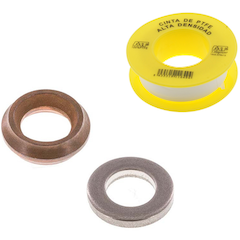
Figure 3: Gaskets and tape
Gaskets and tape create a mechanical seal. Gaskets (rubber or metal) are commonly used between two mating surfaces as they deform and fill the space to form a seal and prevent leakage. They are commonly used on pressure gauges. Sealing tape, also known as Teflon tape or Plumber’s tape is mostly used as a thread sealant for water pipes and fittings. It is a white, non-sticking tape wrapped around the male thread before connecting to the female thread and acts as a filler for a tight, leak-free connection.
Gaskets and Tape Online Selection
Instant adhesives
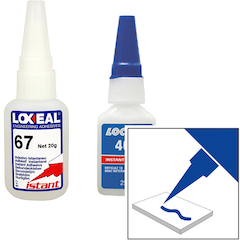
Figure 4: Instant adhesives
Instant adhesives are cyanoacrylate-based adhesives. They cure within seconds on most surfaces at room temperature and allow a very high mechanical resistance in a short time frame. They are available in various viscosities, ranging from completely liquid to dense gels. Three different chemical formulations are used for different purposes: methyl for metals, ethyl as a universal adhesive, and alkoxy as an odor-free adhesive.
Instant Adhesive Online Selection
Joint lockers

Figure 5: Joint lockers
Joint lockers replace traditional welding and mechanical retainers. They lock bearings, sleeves, pin hubs, pulleys, gears, and other cylindrical components to prevent loosening caused by stress and vibration. Joint lockers are chemicals that cure anaerobically and form a strong film in the holes between the joints of the connection, locking it in place.
Surface modifiers
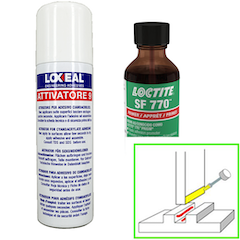
Figure 6: Surface modifiers
Surface modifiers are used before an adhesive is applied, as they clean and prepare the surface. Surface modifies clean, de-oxidize, remove dirt, oil, fats, and other chemicals from the surface to ensure a good substrate-adhesive bond and ideal curing conditions. Using these will improve the quality of the sealant or locker to lower your overall maintenance cost long-term. Read our surface modifier article to learn more.
Surface Modifier Online Selection
Threadlockers
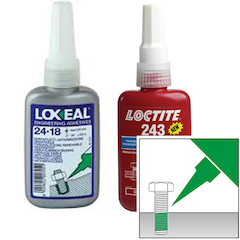
Figure 7: Threadlockers
Threadlockers are used to lock bolts, studs nuts, and screws and to avoid loosening caused by stress and vibration. Threadlockers are chemicals that cure anaerobically and form a strong film in the holes between the thread of the connection, locking it in place. They replace traditional mechanical washers and fasteners. These chemical solutions are suitable to lock bolts, stud nuts, and screws in place but do not offer any sealing properties. Take a look at our thread sealants for this application. Read our threadlocker article to learn more. Read our Loctite threadlocker color article to understand the differences in Loctite products.
Thread sealants
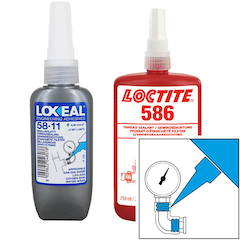
Figure 8: Thread sealants
Thread sealants are chemical solutions that cure anaerobically and expand in the holes between the thread of the connection. Furthermore, sealants function as lubricants as the threads are forced together. They do not develop cracks or shrink and they create an air-tight and water-proof seal. Most liquid thread sealants are PTFE based. Thread sealants can be used with a wide range of materials and are resistant to high temperatures, high pressure, vibration, and various chemicals. Due to their properties, they replace traditional PTFE tape or hemp fiber. Read our thread sealant article to learn more.
Thread Sealant Online Selection
Product selection guide
- Do you need to clean and prepare the surface beforehand?
- If yes, it is smart to start with a surface modifier.
- Are you connecting two PVC components?
- If yes, use a PVC fitting adhesive.
- Do you want a mechanical seal?
- If yes, gaskets and tape are a good in-expensive solution.
- Do you want a liquid gasket?
- If yes, use a face sealant
- Do you need to join together two flat surfaces?
- If yes, use an instant adhesive.
- Are you replacing traditional welding and mechanical retainers?
- If yes, use a joint locker.
- Are you threading components together and want to keep them locked together and prevent leakage?
- If yes, use a threadlocker.
- If you just want to prevent leakage, use a thread sealant.




